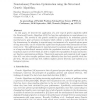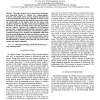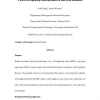55 search results - page 3 / 11 » Adaptation of Length in a Nonstationary Environment |
PPSN
1992
Springer
13 years 11 months ago
1992
Springer
In this paper, we describe the application of a new type of genetic algorithm called the Structured Genetic Algorithm (sGA) for function optimization in nonstationary environments...
ICONIP
2009
13 years 5 months ago
2009
Reinforcement learning induces non-stationarity at several levels. Adaptation to non-stationary environments is of course a desired feature of a fair RL algorithm. Yet, even if the...
VTC
2006
IEEE
14 years 1 months ago
2006
IEEE
Abstract—This paper proposes a new scheme based on information theoretical criteria to estimate the Channel-ImpulseResponse (CIR) length, whose accurate estimate represents one o...
EL
2008
13 years 7 months ago
2008
Purpose Neural document clustering techniques, e.g., self-organising map (SOM) or growing neural gas (GNG), usually assume that textual information is stationary on the quantity. ...
JSAC
2008
13 years 7 months ago
2008
A cognitive radio can sense its environment and adapt some of its features, such as carrier frequency, transmission bandwidth, transmission power, and modulation, thus allowing dyn...



